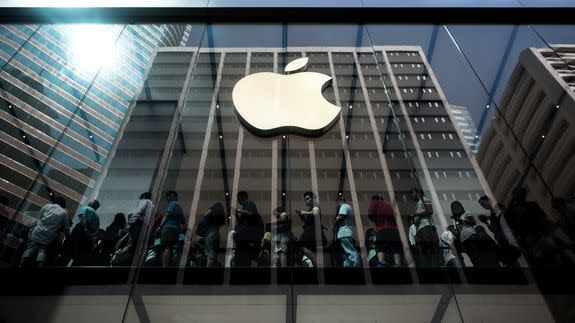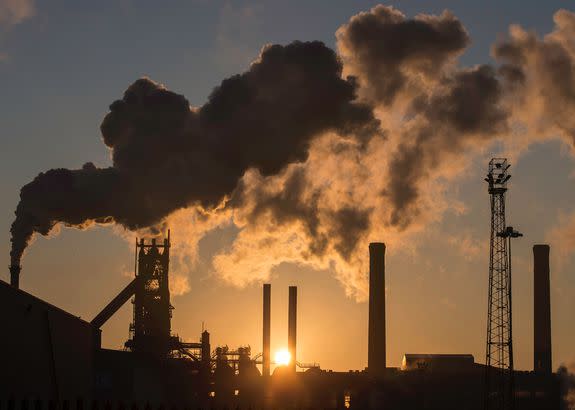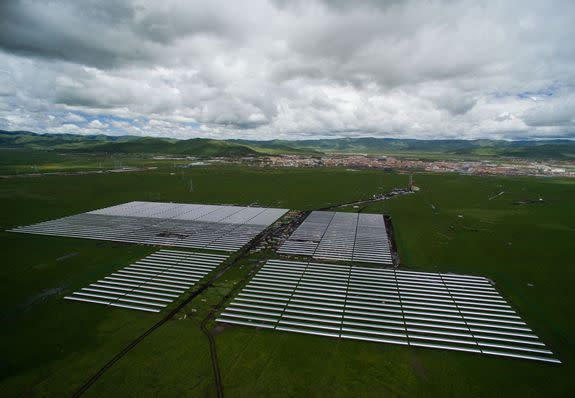Apple aims to clean up its supply chain with new renewable energy goals

Apple says it is fixing a big hole in its clean energy strategy by partnering with its far-flung manufacturers to reduce carbon emissions from factories.
The California tech giant already powers nearly all its data centers, offices and retail stores worldwide with renewable energy sources.
But the third-party suppliers of Apple's iPhone glass covers, antennae bands and other key parts continue to rely on electricity from the burning of fossil fuels, such as coal.
SEE ALSO: How Apple is taking the tech world’s love affair with renewables to a new level
Lisa Jackson, Apple's vice president of environment, policy and social initiatives, announced a handful of initiatives on Monday that will see Apple's manufacturers invest in wind and solar projects and energy-efficiency upgrades.
At the #CWNYC - Lisa Jackson, VP EPS from @Apple - #RenewableEnergy for data centers - now for their #supplychain pic.twitter.com/eAQujIxU3y
— agustina besada (@afbesada) September 19, 2016
"We are firm believers that everybody has a responsibility to address climate change," Jackson said in an address at the launch event for the 2016 Climate Week in New York City. "We're also bringing key suppliers along on this journey with us."
About 77 percent of Apple's total carbon dioxide emissions come from the company's global supply chain, including mainly companies and manufacturing sites that Apple neither owns nor directly operates, said Jackson, who was head of the U.S. Environmental Protection Agency from 2009 to 2013.
This reliance on other, dirtier operations to help supply Apple's products is one of the last major hurdles the company faces in its race to be completely-powered by renewable energy.
"So Apple can say, if you're using iTunes, that's from 100 percent renewable electricity, but they can't necessarily say the same for your Macbook Air," Emily Farnworth of The Climate Group, the non-profit organization running Climate Week, told Mashable on the sidelines of the conference.
Cleaning the supply chain

Image: LINDSEY PARNABY/AFP/Getty Images
Jackson said Apple is working with its global suppliers to install more than 4 gigawatts of new clean energy — including 2 gigawatts in China — by 2020.
She also announced that Solvay Specialty Polymers, which makes the antenna bands used in iPhones, has committed to using 100 percent renewable energy to power its Apple-related operations by 2018. The new pledge involves 14 manufacturing facilities in eight countries: China, India, Belgium, France, Germany, Italy, South Korea and the United States.
Catcher Technology, one of Apple's main suppliers for aluminum iPhone casings, similarly pledged to use 100 percent renewable energy for its Apple-related production within two years.
Those announcements build on past commitments from other Apple suppliers like Foxconn, which recently agreed to install 400 megawatts of solar power to power its iPhone final production facility in Zhengzhou, China.

Image: Bai kelin/Imaginechina
All told, Apple's supply chain is on track to use 1.5 billion kilowatt-hours per year of clean energy to manufacture Apple products by 2018, Jackson said. That amount of electricity is about the same that a million Chinese households consume in a year.
"These acts of leadership by our suppliers are so important, because they demonstrate that the large manufacturers do value where their energy comes from and are increasingly demanding greater amounts of clean energy worldwide," Jackson said in the Climate Week address.
For non-energy and mining companies like Apple, supply chain emissions can contribute four times the amount of emissions from direct operations, according to CDP, a climate advocacy group in London.
The CDP is slated to launch a first-ever ranking in January that will measure how large global corporations manage climate change risks in their supply chains.
Getting to 100 percent renewables
Apple is also working toward an earlier goal to power 100 percent of its direct operations using renewable energy, such as wind and solar power.
Last year, the Silicon Valley behemoth used about 93 percent solar, wind and other clean energy sources to power its data centers, retail stores and offices worldwide, Jackson said.

Image: Jie Zhao/Corbis via Getty Images
On Monday, Apple formally joined the RE100 campaign, an initiative led by the Climate Group to commit major companies to completely ditch fossil fuels in their operations. Other tech giants such as Google and Microsoft have already joined the campaign.
Farnworth, who directs the RE100 campaign for The Climate Group, said Apple's participation also shows how the company is using its ubiquitous brand to influence global discussions on climate change policy.
Apple's commitment on Monday signals to policymakers that "their actions are serious, and that companies really do want better, clean energy," Farnworth said.
